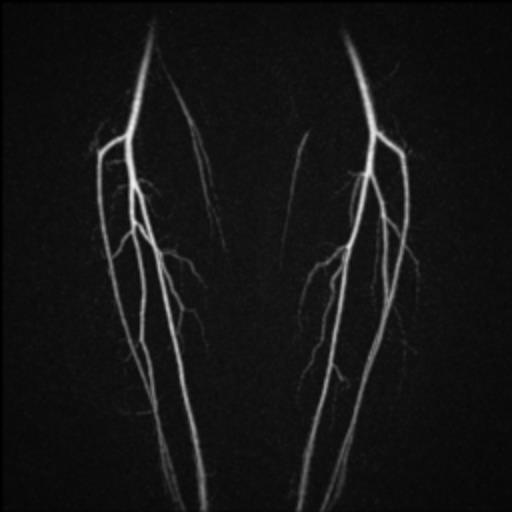

 The broad objective of this research is to develop and evaluate contrast enhanced magnetic resonance angiography (MRA) for accurately diagnosing peripheral vascular disease. The successful outcome of this research will overcome the inaccuracy problem of current MRA and catheter-based x-ray angiography (XRA) in detecting lesions in small distal arteries in the lower calf and feet. The specific aims are 1) develop SNR efficient pulse sequences for peripheral MRA, 2) optimize RF coil for signal reception of the lower extremity, 3) evaluate the accuracy of improved peripheral MRA in patients with peripheral vascular disease. Current contrast enhanced MRA acquisition is based on the Cartesian spoiled gradient echo (SPGR) sequence. The spiral SPGR and the fully refocused gradient echo sequence (steady state free precession, SSFP) can potentially provide much greater SNR than the Cartesian SPGR. Accordingly, spiral and SSFP sequence will be developed for data acquisition of peripheral MRA to provide > 50% increase in SNR. Current RF coils are not optimized for signal reception from the leg and feet. The multiple RF channels in recently disseminated MR scanners offer an opportunity to reduce noise using smaller coils. Accordingly, coil pants consisting of 8 channel orthogonal coil arrays and birdcage arrays will be developed to provide > 100% increase in SNR. Peripheral MRA using spiral/SSFP sequence and optimized coil will have a 200% increase in SNR over current peripheral MRA. The accuracy of this improved peripheral MRA will be evaluated in a group of patients with peripheral vascular disease, using intraoperative x-ray angiography as the gold standard..
The broad objective of this research is to develop and evaluate contrast enhanced magnetic resonance angiography (MRA) for accurately diagnosing peripheral vascular disease. The successful outcome of this research will overcome the inaccuracy problem of current MRA and catheter-based x-ray angiography (XRA) in detecting lesions in small distal arteries in the lower calf and feet. The specific aims are 1) develop SNR efficient pulse sequences for peripheral MRA, 2) optimize RF coil for signal reception of the lower extremity, 3) evaluate the accuracy of improved peripheral MRA in patients with peripheral vascular disease. Current contrast enhanced MRA acquisition is based on the Cartesian spoiled gradient echo (SPGR) sequence. The spiral SPGR and the fully refocused gradient echo sequence (steady state free precession, SSFP) can potentially provide much greater SNR than the Cartesian SPGR. Accordingly, spiral and SSFP sequence will be developed for data acquisition of peripheral MRA to provide > 50% increase in SNR. Current RF coils are not optimized for signal reception from the leg and feet. The multiple RF channels in recently disseminated MR scanners offer an opportunity to reduce noise using smaller coils. Accordingly, coil pants consisting of 8 channel orthogonal coil arrays and birdcage arrays will be developed to provide > 100% increase in SNR. Peripheral MRA using spiral/SSFP sequence and optimized coil will have a 200% increase in SNR over current peripheral MRA. The accuracy of this improved peripheral MRA will be evaluated in a group of patients with peripheral vascular disease, using intraoperative x-ray angiography as the gold standard..